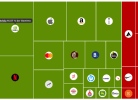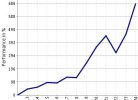Gastbeitrag
Von MITCH ZACKS
Concerns are growing about the strength of the U.S. economy and the longevity of the bull market. Many readers may notice that „recession“ seems to be the hottest trending topic in the news these days, with any bit of negative data being seized upon as a potential canary in the coal mine. I’ve even written about the possibility of recession quite a bit in this space in recent weeks, though my commentary tends to illuminate the hard data underscoring modest – but still positive – economic growth.
As fear and concern grow about the fate of the U.S. economy and stocks, my message to readers is to look the other way – literally. If you see a scenario where economic data and leading economic indicators point to more growth (check), where governments and central banks are posturing for more stimulus (check), but where fear and negativity are getting worse in the news and amongst investors (check), then in my opinion that’s a clear and classic sign that a „wall of worry“ is building. And, based on decades of experience in equity investing, I can tell you that markets love to climb a wall of worry.
I’ll pull an example from earlier this year to help demonstrate the point. Back in early August, many readers will remember the sudden and dramatic August 5th decline when the S&P shed 3.3% and the tech-heavy Nasdaq fell -3.8% in a single trading session.2 In a „Mitch on the Markets“ column just a few days after the decline, I asserted my belief that the downside volatility was a correction (and not a bear market), and reminded readers that „equity market recoveries often happen in ‚v-shaped‘ patterns, which means in many cases, the recovery can happen just as quickly as the decline.“I urged patience in the face of fear.
As you can see in the chart below, concern about the U.S. economy bubbled up as a result of the selling pressure. Data from Google Trends shows that searches for recession in the U.S. spiked at precisely the time the S&P 500 entered a volatile patch:

In my experience, it is during these times – when the market goes haywire and investor sentiment shifts decisively to the negative – that bottoming patterns tend to form.

The S&P 500 Over the Last Year (red line indicates ‚bottoming‘ following August 5)
Source: Federal Reserve Bank of St. Louis4
For long-term investors who ignore the noise and focus on where the markets will likely be in 10, 20, even 30 years, these events often end up being attractive entry points, in my view. In the example above, the proof is in the pudding: it’s only been a little over a month since the big August 5th decline, but the equity markets as measured by the S&P 500 appear to remain in recovery mode. The S&P 500 ended August 5th at 2,844 and as of Thursday was trading close to 3,015.5
Bottom Line for Investors
To be 100% clear, I do not advocate for investors to seek out volatility and negative sentiment as a signal to trade in-and-out of the markets. At Zacks Investment Management, we do not believe in short-term market timing, and as I’ve written many times before, we think investors give themselves the best chance at realizing long-term financial goals by maintaining exposure to risk assets (like stocks) over long stretches of time,in the realm of 20+ years.
The point of making „fear your friend“ is so that as a savvy and experienced investor, you can see when fear bubbles form in the news – even as the U.S. economy continues to grow and economic data remains solid. When you recognize those disconnects, between expectationsabout future growth and realitiesabout future growth, it is easier to resist the urge to make kneejerk reactions to big down days or endless media coverage of recessions and bear markets. It can help you keep a steady hand, which in my view is the key to long-term investment success. To help you stick to the realitiesof the market, I recommend staying focused on the fundamentals and key economic indicators. To help you do this, I invite you to download our Just-Released October 2019 Stock Market Outlook Report.
Herzlichen Dank an Mitch Zacks für den Kommentar zur derzeitigen Volatilität des amerikanischen Marktes. Den Market Outlook von Zacks Investment lese ich regelmäßig und finde ihn immer sehr anregend.
Wenn du keinen Beitrag mehr verpassen willst, dann bestell doch einfach den Newsletter! So wirst du jedes Mal informiert, wenn ein neuer Beitrag erscheint!








……und da Prognosen über den Ölpreis nicht weiterhelfen, sollten wir sie unterlassen. Und dabei beobachten, wie sich die großen Anleger verhalten, ob und wenn ja in welche Regionen und Sektoren sie ihr Kapital lenken.
Ganz so einfach ist es in meinen Augen nicht. Der Ölpreis war an allen Rezessionen der letzten 40 Jahre maßgeblich beteiligt. Schon alleine deshalb ist der gestrige Tag ausgesprochen spannend gewesen. Der Ölpreis konnte enorm zulegen – und der Markt hat es weitgehend ignoriert. Das zeigt, dass die Weltwirtschaft nicht mehr so abhängig vom Öl ist wie noch vor 20 Jahren. Und es zeigt, dass die Weltwirtschaft nicht mehr so abhängig vom Öl aus Saudi Arabien ist, wie noch vor 20 Jahren. Russland und die USA sind nun zwei sehr große Spieler im Markt. Spannend.
Die Rezession kommt, wenn der Ölpreis weiter steigt.
Und sie fällt aus, wenn er wieder fällt. So what?